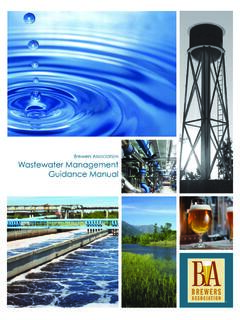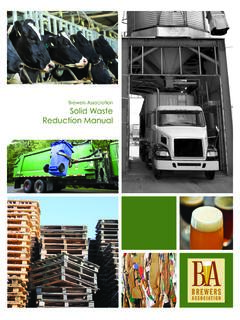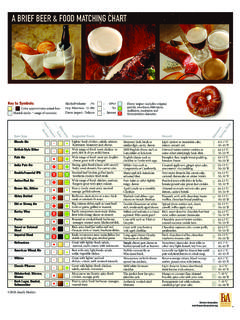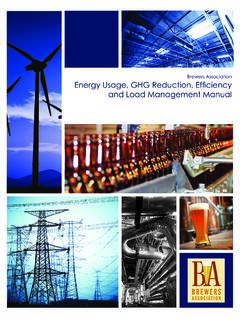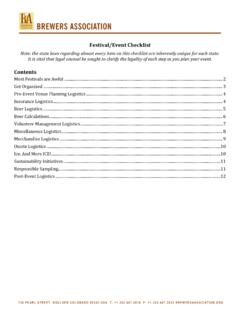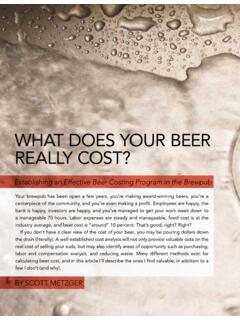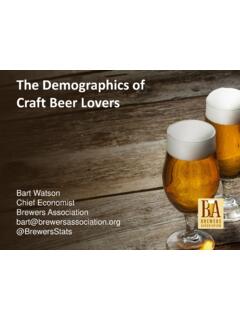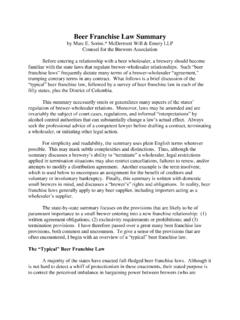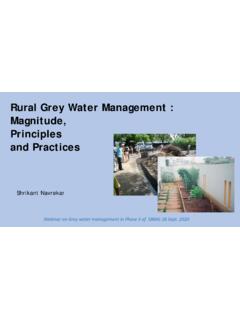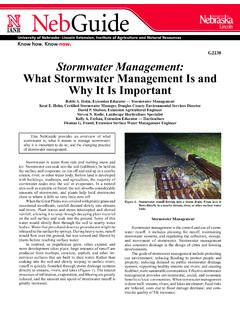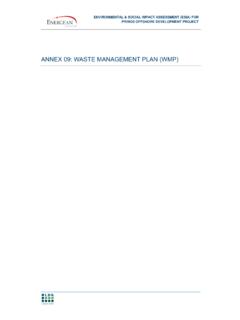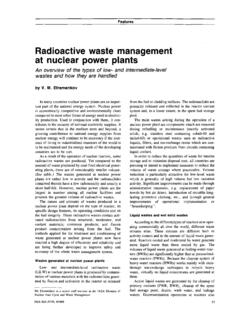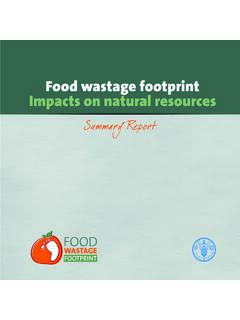Transcription of Brewers Association Water and Wastewater: …
1 1 Water and Wastewater: Treatment/ volume Reduction ManualEnergy Usage, GHG Reduction, Efficiency and Load management ManualBrewers AssociationWater and Wastewater: Treatment/ volume Reduction and Wastewater: Treatment/ volume Reduction ManualAcknowledgements ..4 Introduction ..5 Section 1 Segment Profile: Water Usage & Wastewater Generated by Craft Brewers .. Overview of Current Water Usage & Wastewater Performance Trends .. Regulatory Drivers .. Non-Regulatory Drivers: Image/Brand, Community Ties .. Risks and Opportunities: Water Use Reduction and Wastewater management ..12 Section 2: Data management .. Data Collection .. Ensuring Accuracy .. Benchmarking: Key Performance Indicators (KPIs) .. Guidelines for Setting Measurable Goals and Objectives ..19 Section 3: Usage & Reduction Best Practices .. Brewing ..22 Best Practices - Mash Cooker, Lauter Tun, Boiling Kettle and Whirlpool ..23 Best Practices - Heat Exchangers ..24 Best Practices Fermentation Vessels.
2 24 Best Practices - Yeast Disposal ..25 Best Practices - Filtration ..25 Best Practices - CIP System ..26 Best Practices - Vacuum Pumps ..27 Best Practices - Good Process Sesign ..27 Best Practices - Chase Water .. Packaging..27 Best Practices - Cask and Keg Washing ..28 Best Practices - Cask and Keg Filling ..29 Best Practices - Glass Bottle Washing and Pasteurizing .. Warehousing .. Support Systems (Utilities) ..30 Best Practices - Cooling towers ..30 Best Practices Steam generation ..31 Best Practices - Compressors .. Food Service ..32 Best Practices - Dishwashing ..32 Best Practices Refrigeration ..33 Best Practices - Grease Traps ..33 Best Practices Dining area ..33 Best Practices - Restrooms ..34 Best Practices Parking Lot/Landscape .. Concerts/Events ..35 Section 4: On-Site Wastewater Treatment .. pH Neutralization .. Solids Removal .. Biological Treatment ..37 Section 5: Brewery Case Studies .. Water Reduction ..40 Bell s Brewery Kalamazoo, Michigan.
3 40 Long Trail Brewing Company Bridgewater Corners, Vermont ..40 New Belgium Brewing Company Fort Collins, Colorado ..40 Sierra Nevada Chico, California ..40 Standing Stone Brewery Ashland, Oregon .. Wastewater Pre-treatment ..41 Bluetongue Brewery Warnervale, Australia ..41 City Brewing Company, La Crosse, Wisconsin ..41 Long Trail Brewing Company - Bridgewater Corners, Vermont ..41 Sierra Nevada Chico, California ..41 Stone Brewing Company Escondido, California .. Community Outreach ..42 Founders Brewing Company Grand Rapids, Michigan ..42 New Belgium Brewing Company Fort Collins, Colorado ..42 Appendix A: Tool Box ..43 Guidance and Checklists ..43On-Line Excel-Based Tools ..43 References ..44 Selected Web Links ..46table of contentsCover photos Shutterstock, LLC. Interior photos provided by Antea Group unless otherwise project would not have been possible without the support of many Brewers Association members. The case studies they provided illustrate the creativity and application of sustainability best practices in the craft brewing sector.
4 Our particular thanks go to the following core review team members, who provided invaluable insight and direction throughout the development of this document:Cheri Chastain, Sierra Nevada Brewing CompanySteve Crandall, Devils Backbone Brewing CompanyDaniel Del Grande, Bison BrewingTom Flores, Brewers AlleyMatty Gilliland, New Belgium Brewing CompanyLarry Horwitz, Iron Hill BreweryChris Opela, Brewmaster, Inc. Chris Swersey, Brewers AssociationMike Utz, Boulevard Brewing CompanyWe would also like to thank the sustainability management consulting team from Antea Group who developed this manual and related tools, and in particular acknowledge Antea Group s Project Leader John and Wastewater: Treatment/ volume Reduction Manualbest practices in this manual will help provide tools needed to work towards optimal efficiency, as well as to ease potential future risks and enhance community value. This manual is a consolidated resource for effective Water and wastewater management solutions in the craft brewer segment.
5 Solutions outlined can apply to all breweries, regardless of location and operational size. It will provide guidance for small Brewers that are just beginning to explore Water and wastewater reduction programs, as well as provide new ideas for Brewers that are looking to improve a well-established program or build improved efficiency into expansions or new facilities. Brewers will also find tools they can easily incorporate to integrate Water use reduction and conservation measures into everyday operations and to identify on-site wastewater treatment opportunities. In addition, there are checklists, resource lists, and other visual tools throughout the manual and in Appendix A to help breweries make informed decisions about Water usage and wastewater reduction opportunities. Disclaimer: the following information provided constitute suggestions that may or may not fit the need of each brewery specifically.
6 Brewers should proceed with caution when implementing any new programs. It is not guaranteed that operating under the guidance of this manual will lead to any particular outcome or result. Craft Brewers are innovative leaders in the beverage sector. The breweries take pride in developing new products and processes that give both brewery employees and customers options for sustainable living. Despite significant improvement over the last 20 years, Water consumption and wastewater disposal remain environmental and economic hurdles that directly affect breweries and the brewing process. It is no surprise that many breweries have found innovative solutions for Water and wastewater management . These solutions go beyond facility Water conservation programs to find collaborative, sustainable solutions for the community and for the environment. The abundance of clean, affordable Water in the United States has created complacency among users and the public.
7 Businesses, municipalities and academia all agree that the current usage rate with future population growth may create an unsustainable pattern. Given these pressing concerns, Brewers need to be mindful of the future risks of cost and supply, which are key staples of a growing business. While the average Water use ratio for a brewery is around seven barrels of Water to one barrel of beer, many craft Brewers are world leaders with ratios below three to one. Although the payback for reducing Water usage is typically longer than recommended using standard financial calculators, the long-term sustainability and growth of a business may depend on the ability to efficiently use Water resources. The introduction1 . Segment Profile: A discussion of Water usage and wastewater effluent trends, where to find information on regulatory drivers, examples of non-regulatory drivers, and risks and opportunities for cost savings.
8 2 . Data management : A guide to identifying the components of Water and wastewater information, establishing key performance indicators and goals, managing Water and wastewater data, and benchmarking progress toward goals. 3 . Best Practices: Guidance on best practices to reduce Water usage and wastewater generation focusing on opportunities in the brewing process, including packaging, warehousing, utilities, and food . Onsite Wastewater Treatment: An overview of drivers for onsite wastewater treatment and example technologies. 5 . Case Studies: Selected brewery examples which provide more detail of Water and wastewater reduction programs. The information presented is a pathway to effective and sustainable Water and wastewater management from start to finish. This information is organized into five sections: I am convinced that, under present conditions and with the way Water is being managed, we will run out of Water long before we run out of Peter Brabeck-Letmathe,Chairman Nestl awareness and conservation practices provide an effective mechanism for Brewers to reach out into communities.
9 Outreach efforts have a number of benefits, including building brand image and being recognized as an important part of the community. Community BenefitsEconomic: Helps sustain community growth and business investment. Results in better bond ratings that help communities in need of financing. Helps cities and communities showcase their waterfront areas and commitment to clean Water , thereby supporting new development and encouraging related commerce. Environmental: Helps decrease the pollution in waterways that harms wildlife and the ecosystem. Reduces Water and energy usage, leading to a decrease in greenhouse gas emissions and less strain on natural resources. Ensures that community natural resources and wildlife will be protected. Beer is about 95% Water in composition; however, the amount of Water used to produce a container of beer is far greater than the amount of Water contained in the beer that is actually packaged and shipped out.
10 Although Water usage varies widely among breweries and is dependent upon specific processes and locations, the average is about seven barrels of Water for every barrel of beer produced . Most craft Brewers receive their Water from municipal suppliers, while a few use well Water as an alternative source. In addition to the Water used in production, wastewater generation and disposal presents another improvement opportunity for Brewers . Most breweries discharge 70% of their incoming Water as effluent. Effluent is defined as wastewater that is generated and flows to the sewer system. In most cases, brewery effluent disposal costs are much higher than Water supply costs. In many communities, breweries may be the largest consumer of Water and the largest source of organic effluent that must be treated by the municipal treatment plant. This presents unique supply and cost concerns. In the , the cost of incoming Water from a municipal supplier (tap fee) is relatively inexpensive compared to other brewery utilities.
